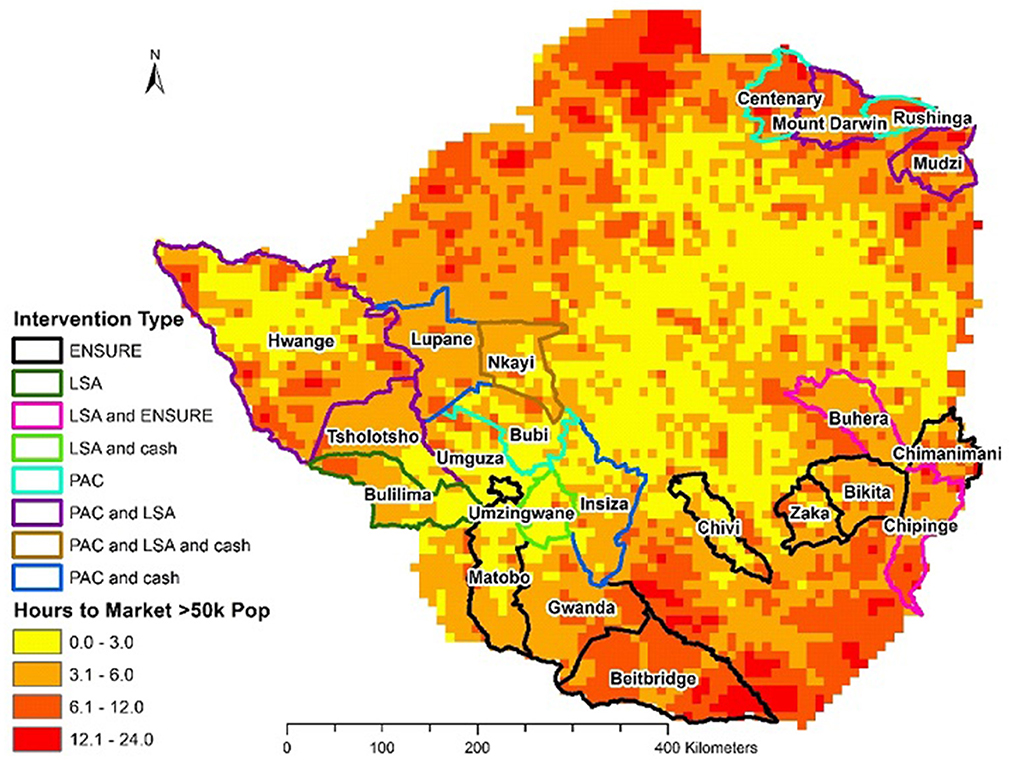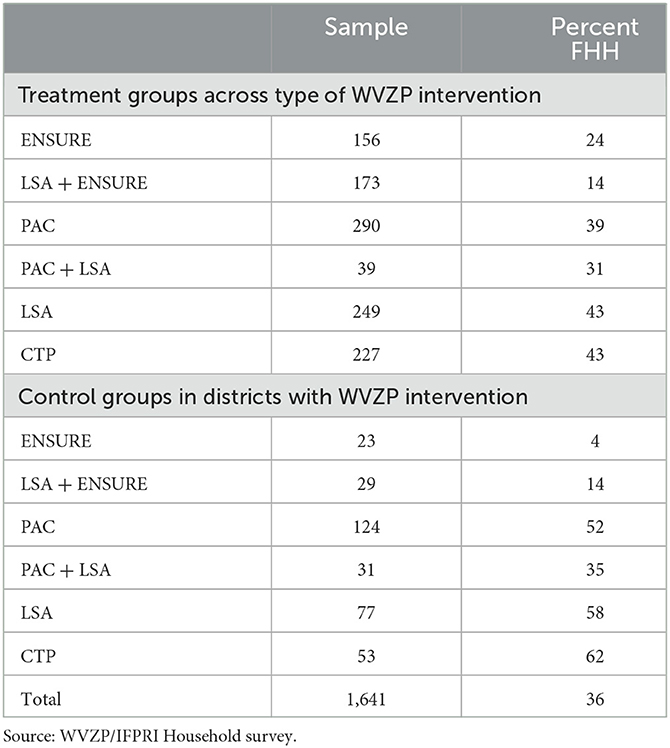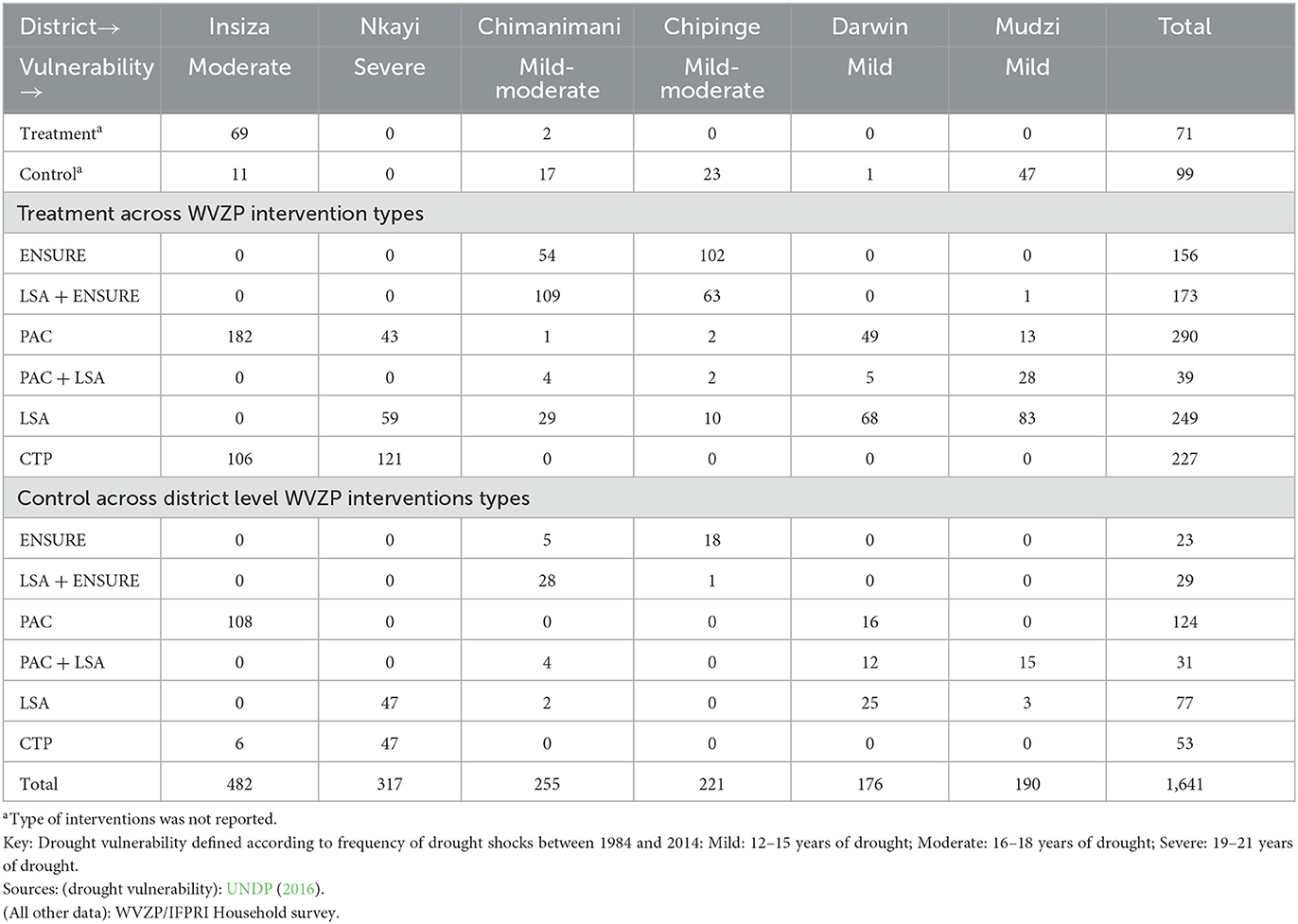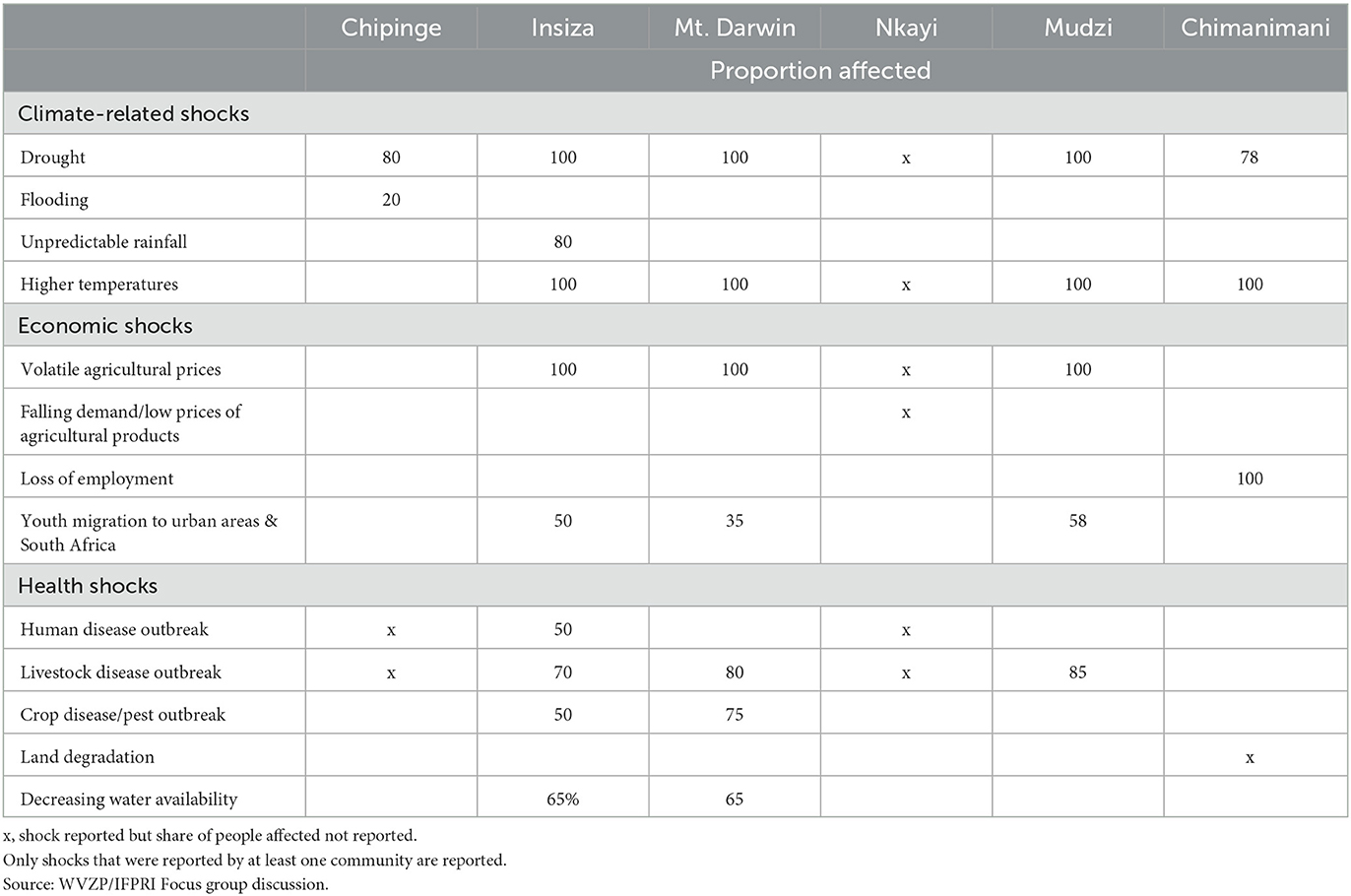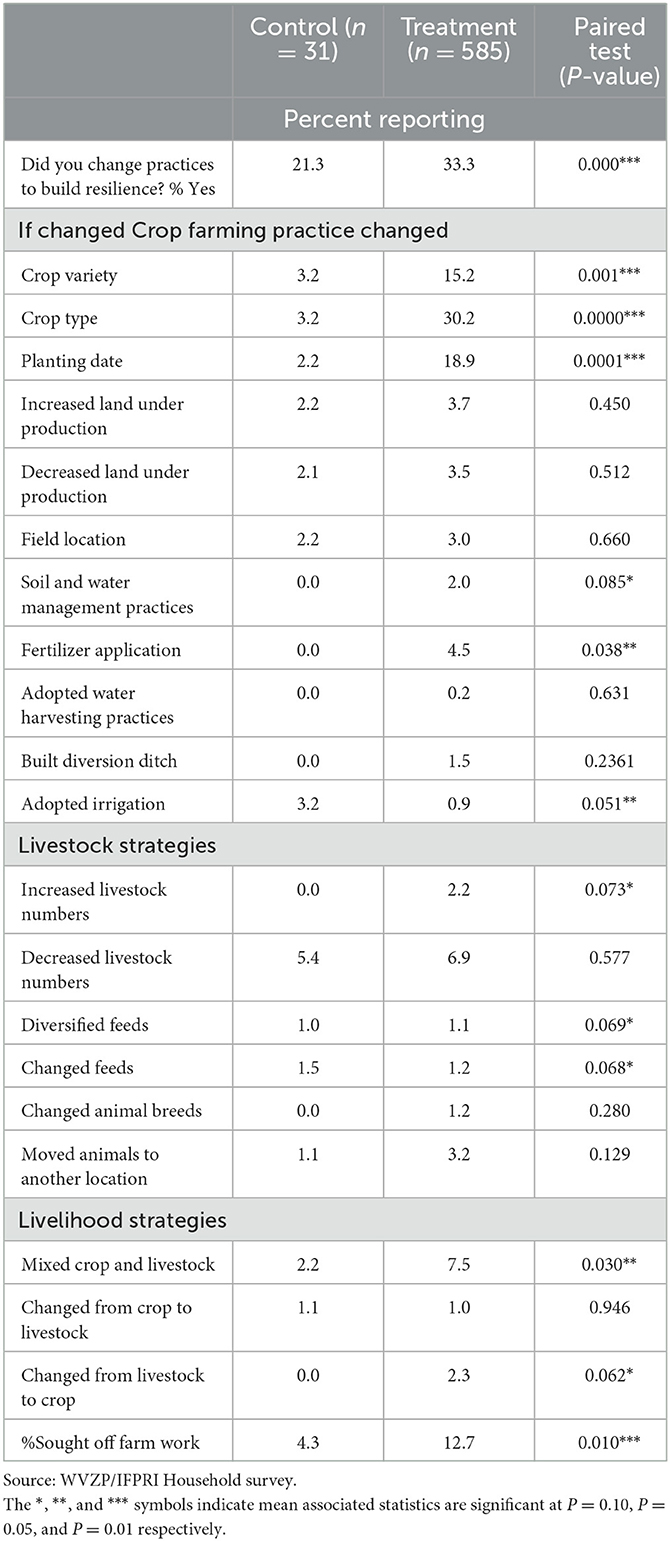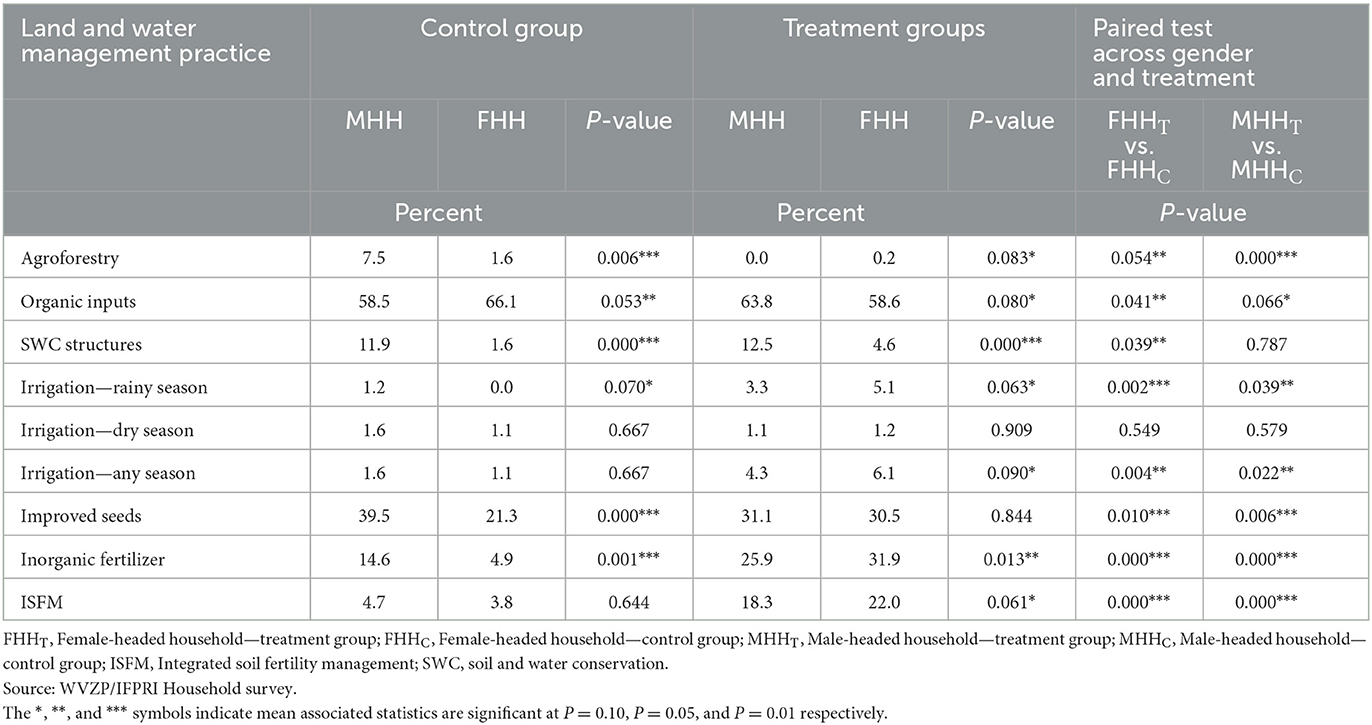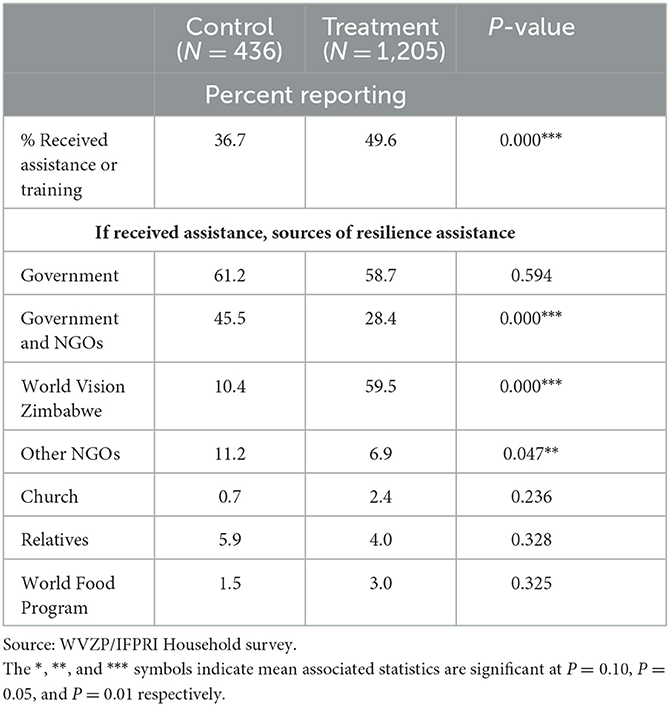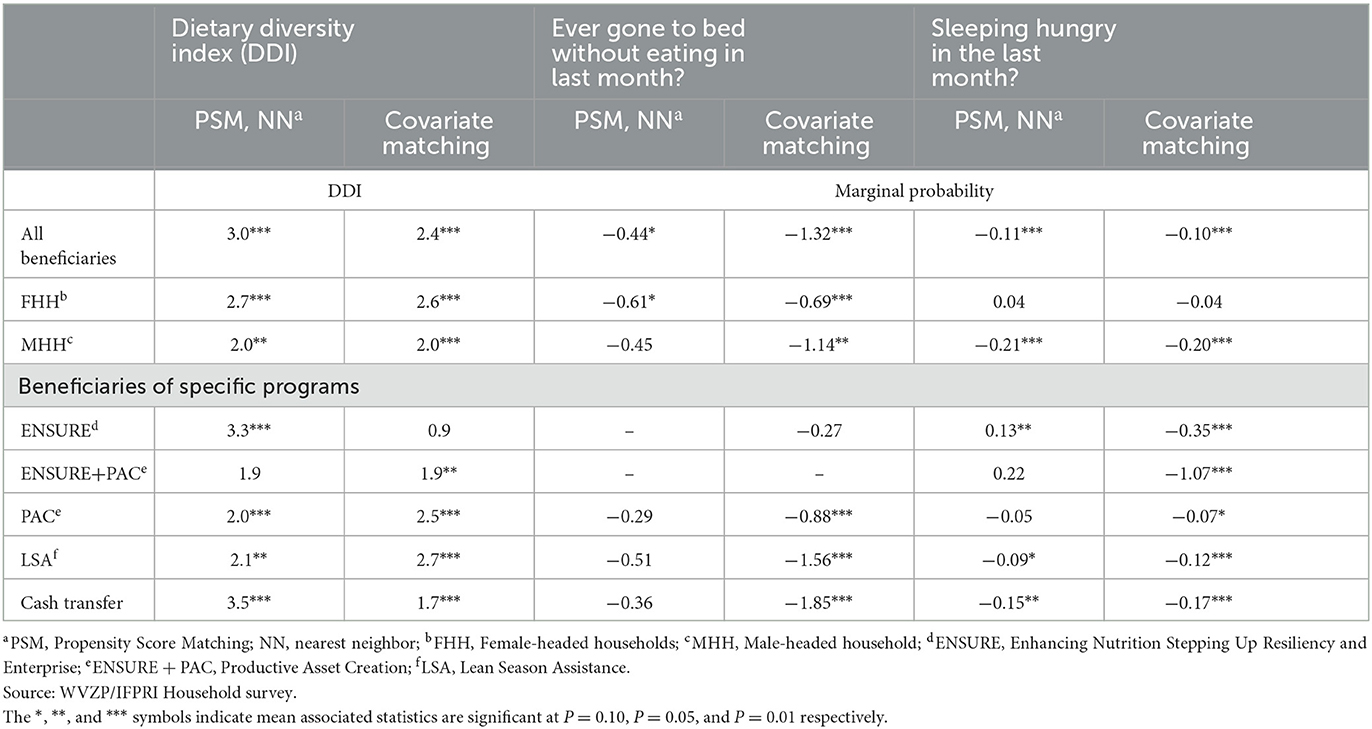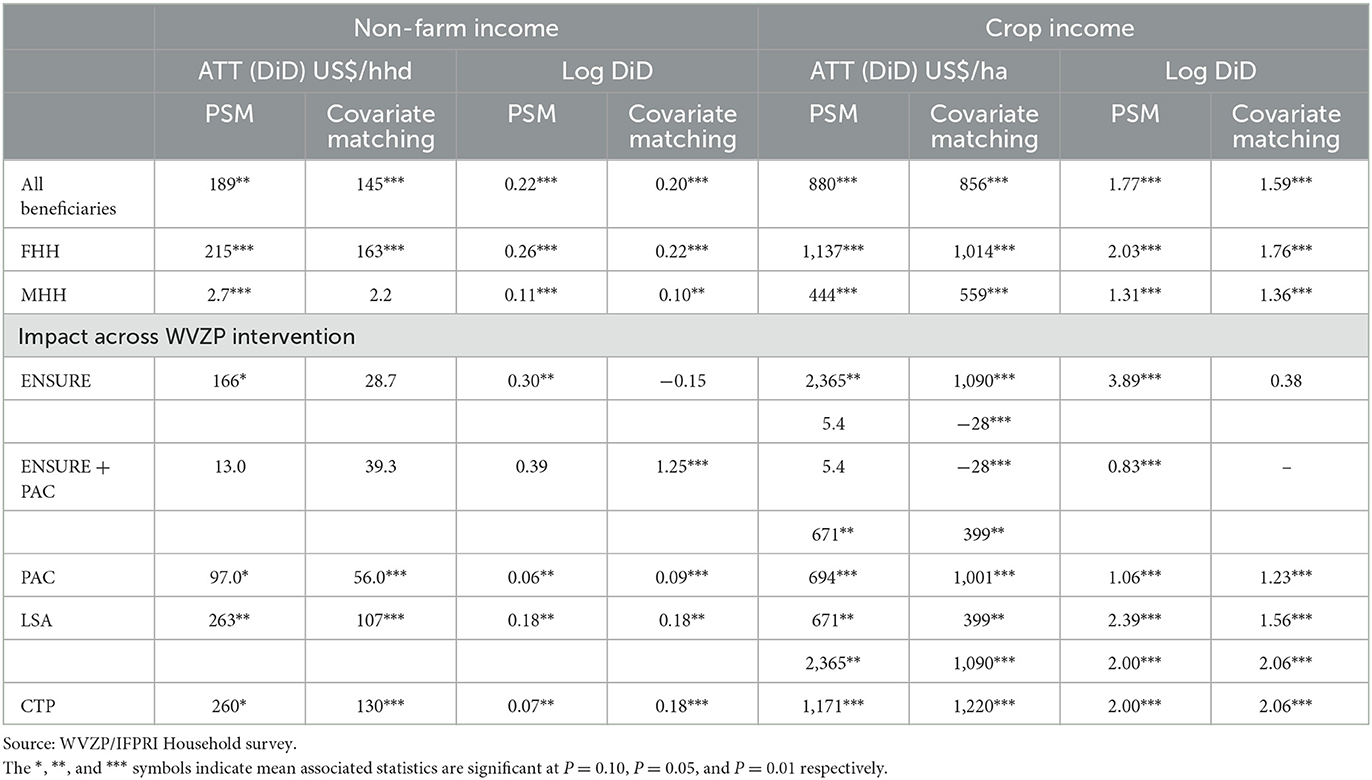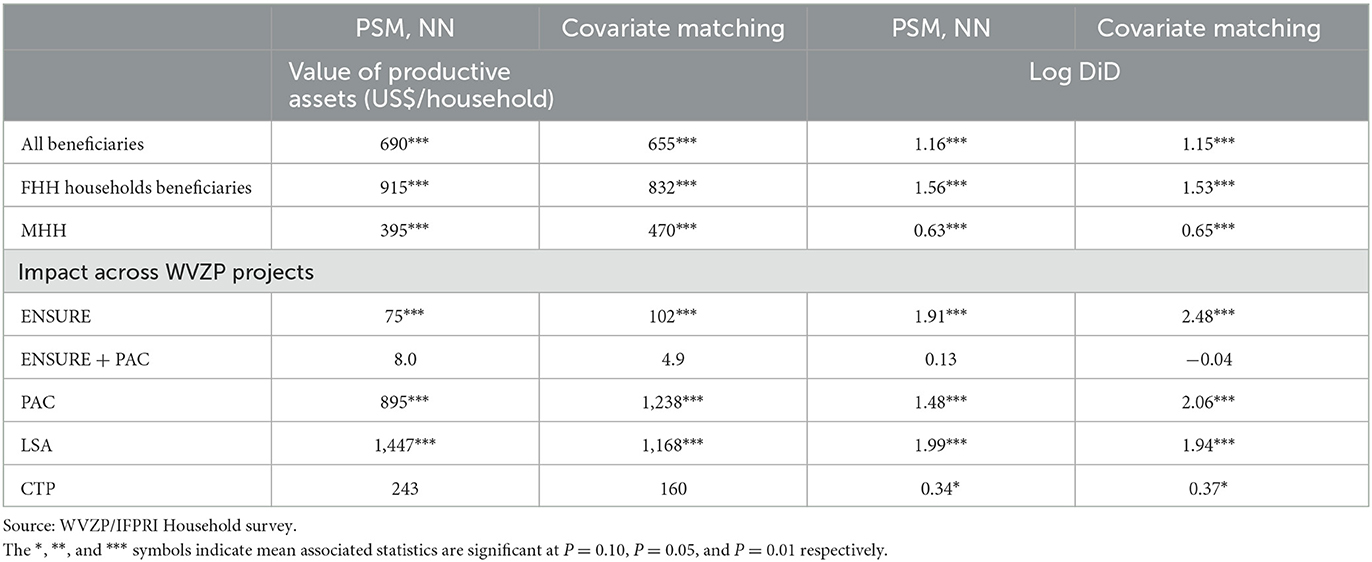- 1Environment and Production Division, International Food Policy Research Institute, Washington, DC, United States
- 2Strategy, Evidence and Learning Department, World Vision Zimbabwe, Bulawayo, Zimbabwe
Climatic shocks are exerting pressure on livelihoods of Zimbabwe's smallholder farmer—who irrigate only 2% of their farms. The smallholder farmers in drought-prone areas are more exposed to drought because of their limited ability to cope with shocks and their greater concentration in less favorable climatic regions. This study was done to analyze shock-response approaches, which farmers use to cope with climatic shocks. Both quantitative and qualitative approaches were used to analyze impact of World Vision Zimbabwe (WVZ) and other actors' interventions on farmer resilience to climatic shocks. Results show that mixed cropping and diversification in general were among the major strategies that pastoralists and crop farmers used to cope with climatic shocks. Crop farmers diversified types of crops as well as raising livestock. Similarly, pastoralists started growing short-term crops. Other coping strategies included intercropping, selling livestock, moving livestock to other places that did not experience drought. Both crop producers and livestock keepers engaged in nonfarm activities. About 60% of WVZ households reported that World Vision and partners helped them respond to shock and build resilience against climate change. These coping strategies had favorable impacts on household welfare. Diversification increased dietary diversity index by more than two and the increase was much greater among female-headed households than male-headed households. The WVZ intervention also significantly reduced the odds of going to bed without eating food or sleeping hungry. Non-farm income and value of assets for WVZ beneficiaries increased by about 20% and by 22% among treated female-headed households. The results show that diversification and providing grass root training of smallholder farmers increases their resilience to climate shocks.
Introduction
Drought, climate change and other climatic shocks are exerting pressure on Zimbabwe's economy, a country that heavily relies on rain fed agriculture as only 4.6% of cultivated area is irrigated (FAO AQUASTAT, 2020). The level of irrigation among smallholder farmers—who account for 80% of agricultural land—after the fast-track land redistribution program (FTLRP)1—is much smaller as only 2% of their cropland is irrigated compared to 6.8% for commercial farmers (Moyo et al., 2017). Additionally, only 37% of the country receives rainfall considered adequate for agriculture. This makes irrigation development a prerequisite for reliable agricultural production in 63% of Zimbabwe's land area. The smallholder farmers are more vulnerable to drought and other natural shocks because of their greater concentration in less favorable climatic regions—and consequently greater risks to rainfall variability and lack the capacity to cope with such shocks (Benson and Clay, 1994). The vulnerability continued even after FTLRP which did not affect significantly ownership of the marginal lands in the communal areas (Ossome and Naidu, 2021). The frequency and intensity of hydrological shocks—largely drought and flooding—are increasing over time due to climate change. Between years 1993 and 2012, rainfall variability in Zimbabwe increased by 21% compared to its long-term average (1901–2012) (Harris et al., 2014). Consequently, smallholder farmers are likely to face much greater risks.
Given the effects of climate change and the consequent increase frequency and intensity of hydrological shocks, developing country governments and their development partners have been rethinking the past “fire-brigade” approach in which the international community and governments only respond through humanitarian assistance when drought or other events occur and do not invest in building long-term resilience against shocks. The new paradigm has been to build resilience by helping the ultra-poor and vulnerable people escape from poverty and transition from emergency programs to sustainable food and nutrition security and livelihoods (Barrett and Constas, 2014). The definition of resilience differs but, in this study, we use the United Nations Development Program (UNDP) definition of resilience—i.e., “the ability …. to cope with shocks and stresses, to recover from those stresses, and to …. achieve sustained, positive and transformative change” (UNDP and WFP, 2016).
There have been several interventions in Zimbabwe to build resilience of smallholder crop farmers and pastoralists who live in arid or semi-arid regions—which account 80% of the country's land area (Jacobs et al., 2013). One of such interventions is the World Vision Zimbabwe (WVZ)—which implemented projects with an objective of building resilience to climatic shocks in the drylands of Zimbabwe. The objective of this paper is to examine the smallholder farmers' coping strategies to climatic shocks and the impacts of such strategies on household welfare. One of coping strategies is mixed farming and how it affects smallholder farmers' resilience to climatic shocks. The study particularly examines the impact of the WVZ interventions on smallholder crop farmers and pastoralists' resilience to climatic shocks in the drylands of Zimbabwe. Throughout this paper, we use terms smallholder farmers, pastoralists, farmers and other similar terms. Unless otherwise specified, these terms mean smallholder crop farmers and pastoralists. They exclude commercial crop farmers and ranchers. To motivate this study, the section below discusses Zimbabwe's agro ecological- regions and explores how climate change has changed their extent and degree of vulnerability. This is followed by a discussion on the interventions that WVZ implemented, analytical approaches and data used in this study. Results are then discussed, after which conclusions and policy implications are drawn based on the results.
Zimbabwe vulnerability and impact of climate change
Zimbabwe is divided into five natural regions—or agro ecological zones (Figure 1 and Table 1). Natural region (NR) I—which covers only about 2% of Zimbabwe's land area—has the highest agricultural potential with reliable precipitation above 1,000 mm per year, longest crop growing period and fertile soils. Export crops, namely tea and coffee—are the major crops grown in NR I. Other major crops grown in NR1 include fruit, maize and vegetables. NRI is also suitable for intensive beef and dairy production. NRII receives 700–1,050 mm of rainfall per year and covers about 19% of land area (Table 1). NRII is one of Zimbabwe's breadbaskets owing to its suitability for intensive production of maize—Zimbabwe's staple food crop, tobacco and cotton. NRIII accounts 17% of land area and receives 500–800 mm rainfall annually—which is characterized by frequent drought spells and unreliable onset of rain season. Millet and sorghum are the common crops but maize is also grown in NRIII. Extensive livestock ranching is practiced in NRIII. NRIV accounts for 33% of land area—the largest share—and communal farmers occupy 50% of NRIV. The region receives only 450–650 mm of rainfall annually and rain fed farming is quite unreliable—exposing the farmers to highly risky rain fed production. NRV is the driest and receives <450 mm annually. It is suitable for extensive cattle and game ranching, yet farmers in NRV grow sorghum and millet.
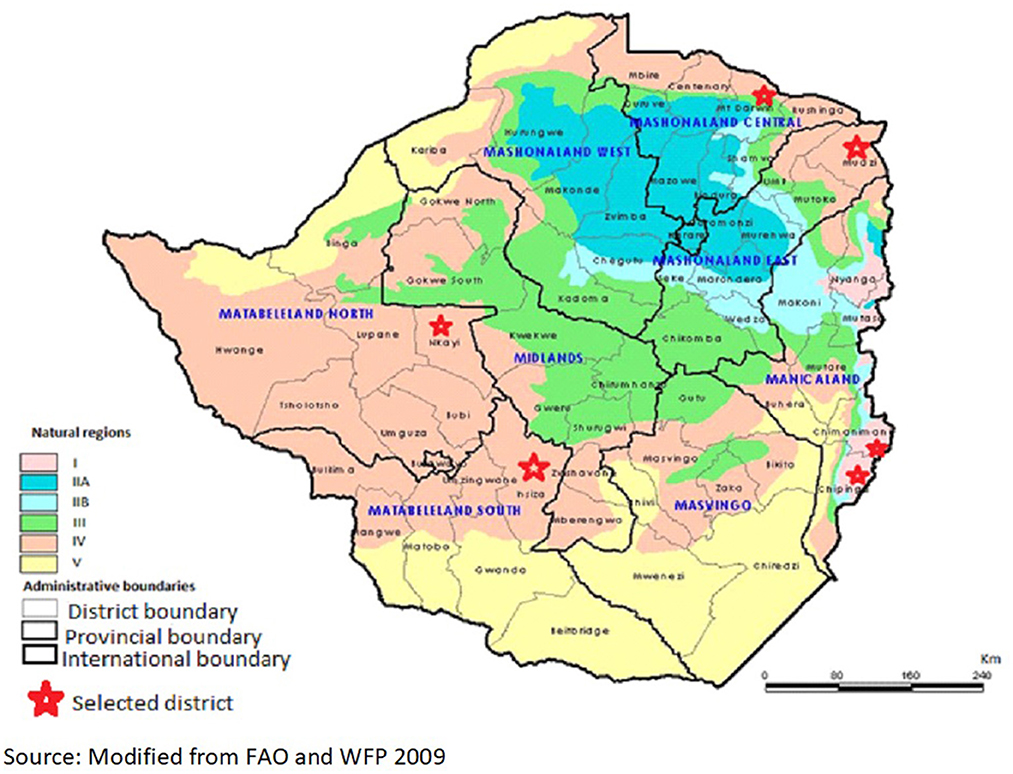
Figure 1. Natural regions and selected districts. Source: Modified from FAO and WFP (2009).

Table 1. Zimbabwe natural regions (agro ecological zones), their change due to climate change, annual precipitation, coverage of area and number of farmers and major farming systems.
Climate change has changed the extent of the five natural regions and this has negatively affected food security in Zimbabwe. Farmers in NRV have been increasingly replacing maize with coarse grain crops—namely sorghum and millet. NGOs and the government have over the years invested in developing farmers' capacity to grow small grains but maize remains the most important crop in NRV. According to Mugandani et al. (2012), NRI has doubled in size—thus giving greater potential for coffee, tea and fruit production. However, given that staple food production is done in NRII, and NRIII, this positive change does not have direct impact on food production. NRII—Zimbabwe's breadbasket—has decreased by 49% and lost much of its area to NRIII—a drier and riskier production zone. NRIII has also decreased by 14% due to encroachment of much drier NRIV. Given that NRIII is also source of cereal production, the loss has negative implication on food security. NRIV extent has increased by about 6% due to its expansion into NRIII. NRV—the driest zone—increased by 23%—ushering in greater vulnerability and need for building resilience against hydrological shocks.
The increasing extent of NR IV and NRV increases vulnerability. The southern and Midwestern part of the country is under severe vulnerability while midlands and northwestern parts of the country has moderate vulnerability.
Interventions
WVZ in collaboration with other development partners have been working closely with the government and have been trailblazing innovative approaches, which are helping the government to design better resilience programs. The section below discusses the major WVZ projects that will contribute to the overall analysis. WVZ implemented the projects ENSURE (Enhancing Nutrition, Stepping Up Resilience and Enterprise); Productive Asset Creation (PAC); Lean Season Assistance (LSA) and cash transfer program (CTP). WVZ has been implementing these projects in collaboration with WFP, CARE, SNV, SAFIRE, USAID, and ICRISAT. Figure 1 below shows a partnership in each of the four projects analyzed. As shown in Figure 2, the four types of WVZP interventions (ENSURE, LSA, PAC, and CTP) were implemented independently or in combination in each of the districts experiencing shocks and with high vulnerability.
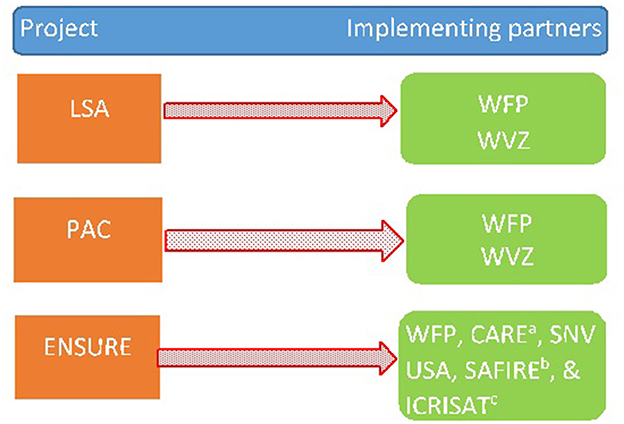
Figure 2. Schematic presentation of the interventions and partnership of WVZ and other projects. aCooperative for assistance and relief everywhere, Inc. implements ENSURE on behalf of CARE. bSAFIRE, Southern Alliance for Indigenous Resources. cICRISAT, International Crops Research Institute for the Semi-Arid Tropics.
For brevity, we will refer to this partnership as World Vision and partners (WVZP). Figure 3 shows the districts which benefitted from WVZ interventions. The figure also shows the market access, an aspect which demonstrates that most of interventions were remote areas.
Enhancing nutrition, stepping up resilience and enterprise (ENSURE)
ENSURE project was implemented in year 2013–2018, followed by a two-year cost extension to 2020. ENSURE major objectives were to
(a) Improve nutrition of women of reproductive age and children under the age of five, increase and improve agricultural production and marketing. The project aimed to provide food rations and health and nutrition training up to 150,000 women of reproductive age and under five-year-old children,
(b) Increase household income. This was to be achieved through farmer field schools (FFS), facilitation of producer associations and their business dealings with agro-dealers. ENSURE also worked to enhance development of Community Savings and Credit Cooperatives (SACCOs) to increase access to financial services and asset accumulation. In total this activity was targeted to reach 20,000 people.
(c) Enhance resilience and response to hydrological and other shocks. This was achieved through training communities on methodologies for increasing their resilience against shocks and Food for Asset (FFA)—in which communities construct dams, irrigation schemes, diversification of livelihoods, wells and nutrition gardens. A total of 7,000 people were expected to participate in this food for asset program.
ENSURE set a target of reaching a total of over 215,000 vulnerable people by 2018.
Productive Asset Creation (PAC)2
The main objective of the PAC program is (i) to enhance resilience of beneficiaries to natural and human-induced shocks; (ii) to transform vulnerable households and communities that depend on emergency relief operations to self-sufficient and resilient households. PAC was the second-level phase in which beneficiaries move from humanitarian (safety-net) programs to asset creation. Food insecure and vulnerable communities were selected to work and build community productive assets that have a potential to improve food security. The households providing labor received food rations as an incentive after completion of assigned tasks. PAC is an innovative approach that builds on past efforts that were largely focusing on providing humanitarian food assistance to communities experiencing acute food shortages. Under the asset building approach, beneficiaries are expected to, over time, develop their productive capacities to cope with emergencies arising from drought and other shocks, and eventually transition from dependence on humanitarian relief to surplus production, market participation, and exit from humanitarian assistance programs.
Lean Season Assistance and cash transfer program3
Lean Season Assistance (LSA) is a short-term conditional assistance provided to the most vulnerable households in targeted wards and districts contingent on participation in a livelihoods focused/related training provided by WVZ or its cooperating partners. Cash transfer programs (CTPs) were either unconditional or conditional. Conditional cash transfers (CCT) have been shown to have large impact on nutrition (Hoddinott and Yohannes, 2002). Gilligan et al. (2013) compared cash vs. food transfer in north-eastern Uganda and observed that CCT or unconditional cash transfer had a much larger impact on dietary diversity, food consumption, and frequency of consumption by children, than food transfer. However, WFP's experience in Kenya has shown that cash transfer works in areas with vibrant food markets. In areas with no food market, impact of cash transfer is weak and inappropriate. Studies have also shown that when women have stronger decision making in the household or community and when their asset ownership and control is higher, household welfare is better than is the case when they do not have control over such productive assets (Coppock et al., 2013). Accordingly, cash transfer was made to women in the household. Due to this, FFA is targeting women by ensuring that the bank account holders for cash transfers accounts are women. Transfers are provided as food commodity or cash or a combination of the two. The objective is to help beneficiaries to avoid “fire sales”—in which households under financial distress or dire food insecurity would sell their productive assets at extremely low prices to cope with such crisis. LSA also supported food for asset activities to increase households' resilience to shocks and gradually offset their need for seasonal food assistance. LSA and CTP seeks to improve the nutritional status of children under five, expand and diversify agricultural production, increase household income, and help communities prepare for disasters through disaster risk reduction activities. In response to the drought from El Niño, FFP has supported these development partners to expand food rations and to support the creation of dams and irrigation schemes through food for assets activities. Additionally, by year 2017, LSA was engaged in supporting 5,389 smallholder farmers in Mudzi and Rushinga districts to increase adoption of drought-tolerant small grains and developing market linkages and a predictable demand. Thus, LSA was also involved in the resilience building and not only short-term food needs.
There are many interventions that are being implemented by the national and provincial government to build resilience. Interviews with government officials during the study sought to determine some of the approaches used by WVZ—which are unique and distinct from the national and provincial government approach. The section below discusses the major unique interventions implemented by WVZ.
(i) Multi-pronged approach: The WVZ implemented these projects simultaneously addressing multiple challenge. For example, Figure 3 shows in some districts, there were up to three projects implemented in one district. The PAC and food for asset program addressed both crops and livestock problems. There is a strong component of program and project integration in WVZ's operational areas that complement each other in addressing community gaps and challenges. At minimum, implemented programs have two or more project components that seek to address the complexity of community needs. Long term development projects are complemented by short term grants focusing on diverse areas that address community gaps. For example, water harvesting, rehabilitation of dams and irrigation interventions allowed farmers to grow nutrient dense horticultural crops and water animals. Potable water was also obtained from the water harvesting activities. Multifaced approaches have been shown to have greater impact, cost-effective and more effective than projects which address only one or two problems (Bossuroy et al., 2021). Government and provincial programs tend to be aligned along ministries and department with limited coordination.
(ii) Community involvement in identifying and implementing planned activities: Communities were involved in identifying assets and implementing planned activities. The community participatory planning (CPP) approach was used in implementing the PAC and CTP. Given that the resources are limited, WVZ also had an elaborate conflict resolution and procedure for addressing complaints. This was possible due to the WVZ grass-root presence to implement CTP and PAC. A recent study on social protection showed that Zimbabwe government was among countries with weak mechanism for addressing complaints of beneficiaries and potential beneficiaries of social protection program [United Nations Department of Economic and Social Affairs (UNDESA) and International Labor Organization (ILO), 2021].
(iii) Development Program Approach (DPA): The DPA aims to improve the community's absorptive, adaptive, and transformative capacity through the promotion of integrated programming. Frankenberger et al. (2020) asserts that resilience building is dependent on integrated programming that promotes a cross sectorial approach with long term commitment to improve disaster management, livelihood investment and improved governance and enabling conditions. The ENSURE project implemented projects involving health and nutrition, livelihoods and WASH programming in its life cycle. Communities were empowered to identify lasting solutions to their challenges through an integrated programming implementation. Rolling out project activities fully understood and owned by the community strengthens the drivers of sustainability.
(iv) Programs were aligned with local government development programs. A program implementation team (PIT) has been formed. PIT members comprise local government officials, NGOs and technical staff from government. For example, government agricultural extension and rural health staff are involved in the WVZ programs. The PAC and CTP programs were also used to build capacity of local government staff on how to build resilience of vulnerable communities.
These unique features helps WVZ to contribute to the gaps in the national and provincial government rural development programs.
As illustrated above, all projects included diversification as one of the strategies to cope with climatic shocks. Mixed farming is one of the strategies for diversification strategies. It is under this background that the results of this study are relevant to the objectives of this special issue. The next section discusses the analytical approach and data used to analyze their impacts.
Analytical approaches and data
To increase robustness of results and address weaknesses of analytical methods, we use both qualitative and quantitative approaches.
Qualitative methods
Qualitative methods are used to better understand the knowledge, attitudes, priorities, preferences, and perceptions of target beneficiaries and other stakeholders. Qualitative methods are particularly useful for acquiring a more in-depth understanding of the factors that influence program operations or impacts; and level of acceptability of the approaches by beneficiaries and non-beneficiaries—community leaders, government officials, and other key stakeholders. The qualitative methods included focus group discussions (FGDs) in the selected communities. Two FGDs one with males and one with females, were conducted in selected district. In each district, one ward was randomly selected from which one village was randomly selected for FGDs. Each focus group had a minimum of eight and a maximum of 12 participants. The FGDs focused on community-level strategies to cope with shocks, community perception of the WVZP intervention relevance, effectiveness, and impact. Additionally, FGDs focused on other important aspects related to community economic and social activities that affect resilience and livelihoods in general. Interviews with community key informants and leaders, government officials at district and national levels were done Additionally, interviews with development partners operating in the districts where WVZP was active and other stakeholders who could provide information to help answer some of research questions was done. The qualitative methodological approach used is narrative analysis, which investigates how communities or subjects involved in the study experienced and perceived the issues under consideration (Riessman, 2008) and case-oriented understanding approach (Fischer and Wertz, 2011) which is based on understanding mechanisms of community actions and perception through FGD and other social interaction.
Quantitative methods
The quantitative methods include descriptive analysis, and parametric approaches. As discussed in the next section, household data were used to do the quantitative analysis.
Descriptive statistics
This study also used descriptive statistics to determine the adoption of mixed farming and other intermediate impacts of WVZP interventions on adoption of different coping strategies to climatic shocks. The descriptive statistics will also be used to determine other socio-economic characteristics of the smallholder farmers in the study area. The descriptive analysis will help to better understand the data used in the non-parametric and parametric approaches discussed below.
Parametric approaches
This approach is used to determine the ultimate impacts (human welfare) of the intermediate impacts (coping strategies). To capture the differential impact of WVZP across different groups of beneficiaries, the assessment was disaggregated across gender. Given that WVZP placement was not random, quasi-experimental design was used, in which matching methods (Smith and Todd, 2001) was applied to identify the impacts of WVZ intervention on the selected outcomes. The matching methods select the beneficiaries and non-beneficiaries who have comparable characteristics which affect project participation and outcomes. Matching methods net out the effect of observable time-invariant drivers of project outcomes (Smith and Todd, 2001). After dropping nonmatching observations, the Heckman's difference-in-difference (DID) (Heckman et al., 1998) approach was used to determine the impact of WVZP project:
Where:
= outcome y in baseline period (1) for the treatment group; = outcome y in the endline period (2) for the WVZP beneficiaries group. The outcomes of interest include household income, productive asset creation, food security, child wellbeing, and morbidity.
= outcome y in baseline period (1) for the control group (WVZP non-beneficiaries); = outcome y in the endline period (2) for the control group.
To ensure robustness of results, we use two types of matching methods:
(a) Propensity score matching (PSM)—which matches propensity scores to match program participants (WVZP beneficiaries) and non-participants (control group). Propensity scores are the estimated probability of being included in the project, which are estimated using a probit model. There are different PSM methods but for brevity, we used the nearest neighbor (NN) matching method. The NN approach matches pre-treatment characteristics of treatment and control group and minimizes the distance (measured in terms of propensity scores) between treatment and control.
(b) Covariate matching—which matches program participants and non-participants using variables that determine participation in program and impacts on outcome of interest (e.g. asset ownership). Examples of variables (covariates) that affect program participation include level of education, value of assets before WVZP project intervention, distance to market, etc.
To capture the differential impact of WVZP across different groups of beneficiaries, the assessment was disaggregated across gender and types of interventions groups (CTP, ENSURE, LSA and PAC and some of their combinations as observed at district level). However, the results on disaggregated interventions are less reliable as they are based on a smaller sample size—which further compromises identification of impact. The sampling design was based on only one type of intervention (WVZP)—which lumped all types of intervention into one group—all due to a small budget allocated to this study.
To address the research objectives, the quantitative impact analysis focuses on the following outcomes:
(a) Dietary diversity: Studies have shown that dietary diversity is highly correlated with dietary quality and quantity (Hoddinott and Yohannes, 2002; Marshall et al., 2014). Additionally, dietary diversity is associated with other positive health outcomes including greater birth weight, child anthropometric status, hemoglobin concentration, and reduced hypertension and cardiovascular disease and cancer (Hoddinott and Yohannes, 2002; Ruel, 2003). Dietary diversity index (DDI) is the number of food groups that a household consumed in the last seven days. The nutrition and health training conduced in the LSA and cash transfer was captured in the DDI.
(b) Number of days a household went to bed without eating food or hungry: This is an indicator of food insecurity.
(c) Value of productive assets: The Productive asset creation is one of the most important approach to building resilience against shocks. We examine the change of value of assets among beneficiaries.
(d) Change in household income: We examine the change of household income obtained from crops, livestock and non-farm activities.
Sampling strategy and data collected
Following (Arnab, 2017), we used stratified random sampling in which districts formed the strata. The districts were purposively sampled to reflect severity of vulnerability to drought, and the type of interventions implemented by WVZP (Table 2). Additionally, the purposive selection captured Zimbabwe's geographical and cultural diversity. Six districts—with corresponding provinces in brackets—were purposively selected for the study—Chipinge (Manicaland), Insiza (Matabeleland South), Mt. Darwin (Mashonaland Central), Nkayi (Matabeleland North), Mudzi (Mashonaland East), and Chimanimani (Manicaland) (Figure 1). The WVZP interventions (treatment) in each of the six districts are reported in Figure 1. Even though only Nkayi falls in the severe drought category, the El Niño of 2015–2016 was more severe and could have covered other districts. Nkayi—which experienced the highest frequency of drought events in 1984–2014—benefitted from PAC, LSA and cash transfer program (CTP). Nkayi is in the NRIV—with unreliable rainfall. Mudzi and Mt. Darwin benefitted from PAC and LSA and both largely fall in NRIV—semi-arid conditions regions. NRIV has the largest number of districts due to its severe vulnerability to drought and relatively higher population than NRV.
No baseline data were collected and this forced the present study to collect recall data for period before WVP intervention. The recall data are less reliable—especially for data that are hard to recall—such as data on consumption, land management practices data. Recall survey becomes more difficult as time passes as it heavily depends on respondents having good memory. To partially address this, we avoided asking some data that are too hard to remember.
Power calculation was done to determine the sample size. Using data collected by WVZP from past intervention (post-distribution monitoring data), effect size of PAC and LSA were used to determine sample size. Clustering was done at village level. We assumed statistical power of 90% and level of significance (alpha) of 0.05, and intra-cluster correlation of 0.05. An effect size of 90% and 40% was drawn for PAC and LSA respectively. To obtain conservative estimates, we used the effect size of 40%.
Figure 4 shows the total sample size disaggregated across gender. About 35% and 42% of the treatment and control households respectively were female-headed—a level which is comparable with the national level average of 35.5% of female-headed households in southern Zimbabwe [Zimbabwe Population Census (ZIMSTAT), 2012]. The share of female-headed households in Matabeleland North and South, Manicaland and Masvingo are likely to be higher nationally because of skewed sex ratio—where male: female sex ratio is below 85% [Zimbabwe Population Census (ZIMSTAT), 2012].
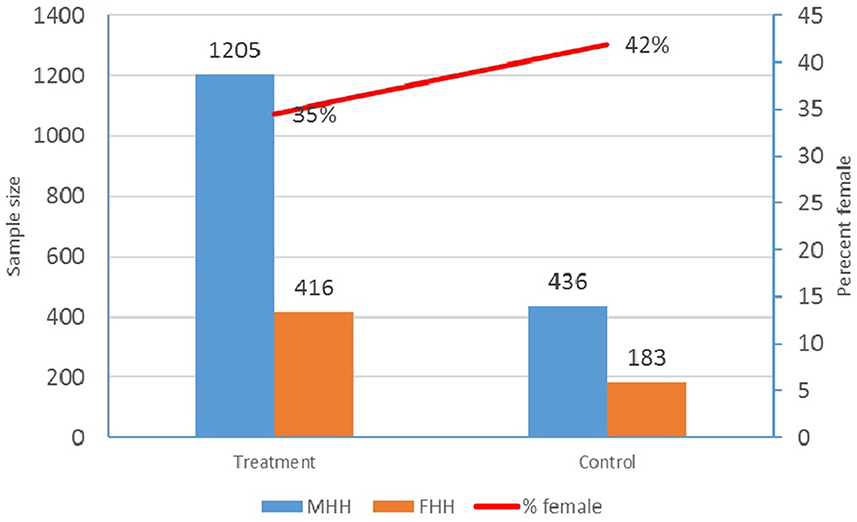
Figure 4. Total sample size and share of female-headed households. MHH, male-headed households; FHH, female-headed households. Source: WVZP/IFPRI household survey.
The control group is smaller (436) because it serves as a comparison group for all treatment groups, whose total sample is 1,205 households. Table 3 reports the sample distribution across type of WVZP intervention.
Results
Drivers of participation in World Vision projects
Compared households whose head has no formal education, households with its head having primary or secondary education are less likely to participate in LSA and ENSURE and PAC (Table 4). This is expected given that households with its head having no formal education are more likely to be poorer and vulnerable to shocks. Likewise, female-headed households are more likely than male-headed households to participate in ENSURE, and ENSURE and PAC. As expected, households who experienced drought, are more likely to participate in all World Vision intervention under study as well as in ENSURE only and in ENSURE and PAC. Likewise, households who experienced flooding are likely to participate in all World Vision intervention under study as well as in PAC and NSURE. As expected, households who experienced food insecurity are more likely to participate in cash transfer. The World Vision interventions aimed to provide cash transfer to households in severe food insecurity and to elevate them to PAC when they have recovered from food insecurity emergence.
We asked the FGD participants to report the shocks and stressors that their community experienced in the past 5 years and share of people affected the most. Table 5 shows that drought was reported in all districts and affected the largest share of people. For example, widespread flooding was reported by media in Chipinge in 2013 and 2017.4
Higher temperatures were also reported in all communities visited. Given its nature, it is not surprising that communities reported that higher temperatures affected all people. Volatile prices and migration of the youth to urban area and to South Africa were the two most frequently reported economic shocks. It is not surprising that share male: female sex ratio is lowest in the southern districts [Zimbabwe Population Census (ZIMSTAT), 2012].
Response to shocks
FGD and household survey results show that the coping strategies taken to address these shocks included:
(i) Selling livestock: FGD results showed that livestock selling is the most common form of coping strategy. All communities interviewed in all six districts reported to sell livestock and this is one of the most coping mechanisms in Zimbabwe (Hoddinott, 2006) and other African countries (Verpoorten, 2009; Giesbert and Schindler, 2012). Households also sold other assets but livestock was the most liquidated asset following a drought. However, the farmers reported that sale of livestock is challenged by the low prices which prevail because the livestock emaciate during drought and that they tend to sell them in the same area affected by drought and thus customers are also poorer and unable to buy at higher prices. For example, in Chipinge, communities reported that they sold their livestock in the local market—where livestock disease outbreak occurred resulting in a quarantine that prevented selling livestock to distant markets. Communities in Nkayi also reported that they have a low bargaining power and the buyers determine the prices and sellers are taken advantage of. Additionally, there is no market information to inform farmers of the prices of beef and live animals in large markets.
(ii) Mixed crop and livestock: Household survey results show that significantly higher share (8%) of beneficiaries of WVZ intervention coped with shocks by mixing crops and livestock than was the case for the control group (Table 6). As expected, mixing crops, livestock and nonfarm activities provides the highest resilience against shocks, especially when intercropping is used (Figure 5). This illustrates that the mixed cropping and diversification in general help smallholder farmers to build resilience to climate change and other shocks.
(iii) Livelihood diversification: The FGD results showed that all communities reported to diversify livelihoods. The most commonly mentioned new livelihood strategies include:
a. Brick making for the very poor. This activity was reported in Chipinge, Insiza, Nkayi and Mudzi.
b. Agricultural marketing: This activity involved buying agricultural products and selling to markets. This activity was done mainly by the youth and women. The youth got engaged in activities that involve traveling to distant markets using bicycle or other means of transportation while women mainly engaged in buying fresh vegetables and fruits, staple food maize, sorghum, millet, beans and cooked foods.
c. Artisanal mining and blacksmith: Artisanal mining and panning was reported in Chipinge, Insiza, Nkayi and Mudzi. This involved mainly male adults. However, opportunities were enhanced by the 2007 Indigenization and Economic Empowerment Act [Government of Zimbabwe (GoZ), 2012; Gochero and Kadira, 2015]—which required largescale miners to engage local people in the mining.
(iv) Migration to South Africa and urban areas in Zimbabwe: The FGD results also showed that young males migrate to South Africa to be engaged in a variety of activities during the lean periods. These include informal cross-border traders, short- and long-term skilled and unskilled migrants, and laborers in mining industries, largescale farmers, etc. (Kiwanuka and Monson, 2009). Migration of the youth to Bulawayo, Harare and other cities within Zimbabwe is also one of the coping strategies. The migrant workers send back money to families left behind.
(v) Moving livestock to other places that did not experience drought: Communities reported moving livestock to other places with better pasture.
The household survey results show the agricultural practices used for adaptation to climate change. Table 6 shows that significantly higher share of treatment households (33%) changed their management practices in response to drought shocks than the case for control households (21%). This shows that the WVZP intervention had a significant impact on building resilience using crop management practices. WVZP beneficiaries who reported to have adopted crop varieties, crop type, planting dates, land management practices, and fertilizer application, was significantly higher than the corresponding share of households in the control group—further showing impact of WVZP. The combination of mixed farming and climate-smart agricultural (CSA) practices are likely to provide a robust resilience against climatic shocks. This underscores the importance of advising smallholder farmers to use a suite of low-cost management practices to build resilience against climatic shocks. This is the approach which WVZ intervention applied.
Control group reported to have used irrigation to enhance resilience more than the treatment group (Table 6). However, the rate of adoption of irrigation among treatment households is significantly higher than the case for the control group (Table 7). The seemingly contradictory results could be due adopting irrigation by treatment group for purposes other than resilience building.
WVZP beneficiaries also reported higher adoption rate of other land and water management practices that enhance resilience to drought. The adoption of irrigation among female-headed WVZP beneficiary households is significantly higher than control female-headed households—underscoring WVZP targeting of women. However, for adoption of agroforestry, the control group did significantly better than the treatment group. So was adoption of improved seeds among men.
Adoption of ISFM, inorganic fertilizer for both male and female-headed households is significantly higher than the corresponding adoption among control group households. This further shows the WVZP success in helping farmers to adopt land and water management practices that enhance resilience.
To illustrate these results, we asked respondents to report the institution that helped them to build resilience. Both the government and World Vision were reported among the leading institutions aiding responding to shocks and building resilience (Table 8). About 60% of WVZP households reported that World Vision helped them respond to shock and build climate change. Government and other NGOs provided more assistance among the control group households than is the case for the treatment group.
Impact WVZP on food and nutrition, asset creation and household income
The analysis below discusses the impacts of WVZP interventions on food and nutrition security, health, productive asset creation and household income. It is based on quantitative data obtained from household survey. The analysis is more rigorous than the descriptive statistics reported above.
Dietary diversity index (DDI) of WVZP beneficiaries significantly increased by more than 2 and the increase was much greater among female-headed households (Table 9). This shows the LSA and conditional cash transfer—which provided nutritional training—achieved the desired impact—especially among women—who were the target of both programs. The DDI increase was much higher in female-headed households than in the male-headed households. As noted earlier, DDI is an important indicator of better nutrition—suggesting that WVZP improved household nutrition—especially among female-headed households. All five types of WVZP interventions in the selected districts showed significant and consistent increase in DDI—further underscoring that they were well-implemented and achieved the desired outcome. As expected, all four interventions (ENSURE, CTP, LSA and PAC) increased DDI. The impact was largest in the cash transfer project.
WVZP programs significantly reduced the odds of going to bed without eat food or sleeping hungry in the last month. This is consistent with the descriptive results that showed that mixed farming and diversification reduced the impacts of climatic shocks on household welfare. However, the reduction of the odds of sleeping hungry was not significant for female-headed households. Consistent with results for DDI, all five WVZP projects significantly reduced the odds of going to bed hungry or without eating food at all (Table 9).
Impact of WVZP on household income
The WVZP impact on non-farm and livestock income is reported in Table 10.5 Non-farm income increased by about 20% and by 22% among treated female-headed households.6 Disaggregating the results across types of WVZP interventions shows that the ENSURE+PAC had the largest impact—as it raised income by 125%. Increase in non-farm and crop income for CTP beneficiaries was the second largest—after ENSURE—underscoring its crucial role for ultra-poor beneficiaries. This shows that combining productive assets and health and nutrition program has the greatest impact on non-farm income than other programs. However, for crop income, LSA increased income by 239% and the results were consistent across matching methods (PSM and covariate) used.
Participation in WVZP projects increased productive assets for both female and male-headed households and the increase among female-headed households was twice as high as the case for the male-headed beneficiaries (Table 11). As expected, the PAC is reported to have the largest impact of productive assets in absolute terms. The value of productive of PAC beneficiaries increased by 150% to 206%. However, ENSURE beneficiaries' productive beneficiaries reported the highest percentage increase (191% to 248%). LSA had the second largest impact and strangely, ENSURE+PAC had the smallest impact and the impact was not significant at P = 10%. CTP impacts on productive asset is weak. This is not surprising given that its objectives are largely humanitarian and not for asset creation.
Conclusions and policy implications
The frequency and intensity of El-Niño, drought and other hydrological shocks have been increasing. Climate change is also changing the agro ecological zones in a way that is increasing food insecurity. It is not surprising that participants in this study reported that drought and decreasing water availability were the most common shocks. This study was done to provide empirical evidence on resilience building approaches that work in Zimbabwe and comparable countries in African and beyond.
Results of the study show that the World Vision Zimbabwe and partners (WVZP) significantly increased adoption of resilience building land and water management practices—such as mixed farming, diversification of livelihoods, irrigation, integrated soil fertility management (ISFM) and other practices. These intermediate impacts of WVZP translated to ultimate impacts—namely food and nutrition security, household income and accumulation of productive assets, all of which significantly increased for beneficiaries compared to the control group. Mixed farming and diversification are particularly crucial in building resilience and enhancing household dietary diversity of smallholder farmers. However, they are likely to be replaced with specialized production when farming moves to largescale and commercial stage.
The results illustrate that WVZP ground-up approach, and provision of both education and food and asset is working as expected. WVZP focus on children welfare and targeting women has also enhanced its success in building resilience. Assessment of the WVZP program done by the communities also support these conclusions. Despite these achievements, WVZP faced challenges—which need to be addressed to increase effectiveness of the resilience building efforts. Duration of the resilience-building efforts was short and this did not provide enough time for building lasting resilience as PAC, and LSA are on average implemented for a period of 6 months of every year. Implementation in the selected district is not guaranteed when going to the next calendar year as targeting is informed by the level of severity concluded on basing on the Zimbabwe Vulnerability Assessment Report.
The immediate achievements of the short term programming were noted to be those that address food insecurity but were limited on other outcomes such as resilience building and or improving nutrition as noted in long term projects such as those implemented by ENSURE. It is against this background that WVZP starting in year 2018, tried to align with the three-year cycle WFP strategy of implementation. WFP is the main partner that collaborates with WVZP in rolling out PAC and LSA. Alignment to the strategy allows for continuation and helps improve on the outcomes such as building resilience than working on short term 6 months of project duration.
There are results, which are very interesting and deserve further discussion. The impacts of all four types of interventions are significantly greater than expected. Additionally, though all four types of interventions were engaged in specific type of interventions, they had positive spill over effects. Specifically, ENSURE and LSA did not focus on asset creation but their beneficiaries reported significantly higher asset accumulation. The results suggest that these interventions offer promises for building resilience. The national level coordination in Zimbabwe is also exemplary and since it helped to build, transformative capacity required building sustainable resilience.
In summary, the WVZP resilience building projects have provided good empirical evidence from which the Zimbabwean government policy making process can learn from as it strives to implement its resilience framework in partnership with development partners.
Data availability statement
The raw data supporting the conclusions of this article will be made available by the authors, without undue reservation.
Ethics statement
The studies involving human participants were reviewed and approved by International Food Policy Research IRB. The patients/participants provided their written informed consent to participate in this study.
Author contributions
EN designed the study analytical methods and wrote the report. EK did the econometric analysis. MM and NN led the data collection and quality control and contributed to data analysis and writing the report. All authors contributed to the article and approved the submitted version.
Conflict of interest
The authors declare that the research was conducted in the absence of any commercial or financial relationships that could be construed as a potential conflict of interest.
Publisher's note
All claims expressed in this article are solely those of the authors and do not necessarily represent those of their affiliated organizations, or those of the publisher, the editors and the reviewers. Any product that may be evaluated in this article, or claim that may be made by its manufacturer, is not guaranteed or endorsed by the publisher.
Footnotes
1. ^Following FTLRP in 2003, irrigated area fell from 200,000 ha to about 120,000 ha due to vandalism and dilapidation of irrigation infrastructure.
2. ^PAC is an ongoing model that started in year 2012 and has been modified over time. It started, as FFA in 2012, changed its name to PAC in 2015, and had its named revised again in year 2018 to Food assistance for Assets to the current period. It usually runs from for a period of about 6 months usually from May to about October of each year during a period where people are not busy in the fields.
3. ^LSA/CTP is an ongoing model implemented during the lean season for an average period of 6 months, usually from October to March of every year. Areas/districts of target are subject to the severity of food insecurity as informed by the Zimbabwe Vulnerability Food Insecurity Assessment. The duration of LSA can be extended to cushion vulnerable communities subject to food insecurity magnitude and in alignment with Government of Zimbabwe declaration of food insecurity tiers. LSA targets the most vulnerable households and it involves either food distribution and or cash vouchers.
4. ^https://www.humanitarianresponse.info/system/files/documents/files/Chivi%20District%20Civil%20Protection%20Report%20on%20Floods.pdf and http://allafrica.com/stories/201701230047.html
5. ^Income from livestock is not reported because the data were available.
6. ^Change expressed in natural logarithm translates into a proportion—which can be converted to percentage by multiplying it with 100.
References
Arnab, R. (2017). Survey Sampling Theory and Applications. New York: Academic Press. doi: 10.1016/B978-0-12-811848-1.00002-9
Barrett, C. B., and Constas, M. A. (2014). Toward a theory of resilience for international development applications. Proc. Natl. Acad. Sci. 111, 4625–14630. doi: 10.1073/pnas.1320880111
Benson, C., and Clay, E. (1994). The Impact of Drought on Sub-Saharan Economies. Available online at: https://www.google.com/url?sa=t&rct=j&q=&esrc=s&source=web&cd=&ved=2ahUKEwiXxYa-lKX2AhURZMAKHS1-BrsQFnoECBEQAQ&url=https%3A%2F%2Fbulletin.ids.ac.uk%2Fidsbo%2Farticle%2Fview%2F1577%2FPDF&usg=AOvVaw3XfrJGqCPBhcyhNIcx-O-f (accessed March 1, 2023).
Bossuroy, T., Goldstein, M., Karlan, D., Kazianga, H., Pariente, W., Premand, P., et al. (2021). Pathways out of Extreme Poverty: Tackling Psychosocial and Capital Constraints with a Multi-faceted Social Protection Program in Niger. Washington, DC: The World Bank. doi: 10.1596/1813-9450-9562
Coppock, D., Tezera, S., Desta, S., Mutinda, N. M., Muthoka, S., Tegegn, G. G., et al. (2013). Cross-border interaction spurs innovation and hope among pastoral and agro-pastoral women of Ethiopia and Kenya. Rangelands 35, 22–28. doi: 10.2111/RANGELANDS-D-13-00039.1
FAO (2004). Agro-ecological Zones Framework and Database for the Review of CGIAR Priorities and Strategies. Rome: FAO.
FAO AQUASTAT (2020). AQUASTAT Database. AQUASTAT. Available online at: https://www.fao.org/aquastat/statistics/query/index.html;jsessionid=2B10973649EEA465F2CCB9C10AA92C90 (accessed March 01, 2022).
Fischer, C. T., and Wertz, F. J. (2011). “Empirical phenomenological analyses of being criminally victimized,” in The Qualitative Researcher's Companion. SAGE Research Methods, eds A. M. Huberman and M. B. Miles (London: SAGE). doi: 10.4135/9781412986274.n11
Frankenberger, R. T., Constas, A. M., Nelson, S., and Starr, L. (2020). Resilience programming among Non-Governmental Organizations, Lessons for Policy Makers. Washington, DC: International Food Policy Research Institute.
Giesbert, L., and Schindler, K. (2012). Assets, shocks, and poverty traps in rural Mozambique. World Dev. 40, 1594–1609. doi: 10.1016/j.worlddev.2012.04.002
Gilligan, D., Margolies, A., Quinones, E., and Roy, S. (2013). Impact Evaluation of Cash and Food Transfers at Early Childhood Development Centers in Karamoja, Uganda. Final Impact Report. Washington, DC: IFPRI.
Gochero, P., and Kadira, G. (2015). Indigenisation and economic empowerment policy views and concerns in the Zimbabwean Mining Sector (2008–2011). J. Econ. Sustain. Dev. 6, 70–77. Available online at: https://core.ac.uk/download/pdf/234647278.pdf
Government of Zimbabwe (GoZ) (2012). Comprehensive Agricultural Policy Framework 2012–32. Harara: GoZ.
Harris, I. P. D. J., Jones, P. D., Osborn, T. J., and Lister, D. H. (2014). Updated high-resolution grids of monthly climatic observations–the CRU TS3. 10 Dataset. Int. J. Climatol. 34, 623–642. doi: 10.1002/joc.3711
Heckman, J., Ichimura, H., and Todd, P. (1998). Matching as an econometric evaluation estimator. Rev. Econ. Stud. 65, 261–294. doi: 10.1111/1467-937X.00044
Hoddinott, J. (2006), Shocks and their consequences across and within households in rural Zimbabwe. J. Dev. Stud. 42, 301–321. doi: 10.1080/00220380500405501.
Hoddinott, J., and Yohannes, Y. (2002). Dietary diversity as a food security indicator. Food Consumption and Nutrition Division Discussion Paper 136. Washington, DC: International Food Policy and Research Institution.
Jacobs, C., Chitima, M., Bwanali, K., and van't Klooster, C. E. (2013). Determinants of the Productivity and Sustainability of Irrigation Schemes in Zimbabwe and Pre-investment Framework. Washington, DC: World Bank.
Kiwanuka, N., and Monson, T. (2009). Zimbabwean Migration into Southern Africa: New Trends and Responses. Oxford: Oxfam GB/Forced Migration Studies.
Marshall, S., Burrows, T., and Collins, C. E. (2014). Systematic review of diet quality indices and their associations with health-related outcomes in children and adolescents. J. Human Nutr. Diet. 27, 577–598. doi: 10.1111/jhn.12208
Moyo, M., Van Rooyen, A., Moyo, M., Chivenge, P., and Bjornlund, H. (2017). Irrigation development in Zimbabwe: understanding productivity barriers and opportunities at Mkoba and Silalatshani irrigation schemes. Int. J. Water Resour. Dev. 33, 740–754. doi: 10.1080/07900627.2016.1175339
Mugandani, R., Wuta, M., Makarau, A., and Chipindu, B. (2012). Re-classification of agro-ecological regions of Zimbabwe in conformity with climate variability and change. African Crop Sci. J. 20, 361–369. Available online at: https://www.ajol.info/index.php/acsj/article/view/81761
Ossome, L., and Naidu, S. C. (2021). Does land still matter? Gender and land reforms in Zimbabwe. Agrarian South J. Polit. Econ. 10, 344–370. doi: 10.1177/22779760211029176
Ruel, M. T. (2003). Is dietary diversity an indicator of food security or dietary quality? A review of measurement issues and research needs. Food Nutr. Bull. 24, 231–232. doi: 10.1177/156482650302400217
Smith, J., and Todd, P. (2001). Does matching overcome LaLonde's critique of non experimental estimators? J. Econometr. 125, 305–353. doi: 10.1016/j.jeconom.2004.04.011
UNDP (2016). Mapping of Selected Hazards Affecting Rural Livelihoods in Zimbabwe. New York City: UNDP.
UNDP and WFP (2016). Overview of Technical Analysis for the Zimbabwe Resilience Building Fund. UNDP and WFP.
United Nations Department of Economic and Social Affairs (UNDESA) and International Labor Organization (ILO) (2021). Global research on governance and social protection. Glob. Overview. Available online at: https://www.un.org/development/desa/dspd/wp-content/uploads/sites/22/2021/08/Global-overview_SP-Governance_June-2021.pdf (accessed June 4, 2022).
Keywords: mixed farming, intercropping, resilience, impact, Zimbabwe, climatic shocks, climate change
Citation: Nkonya E, Kato E, Msimanga M and Nyathi N (2023) Climate shock response and resilience of smallholder farmers in the drylands of south-eastern Zimbabwe. Front. Clim. 5:890465. doi: 10.3389/fclim.2023.890465
Received: 06 March 2022; Accepted: 09 March 2023;
Published: 30 March 2023.
Edited by:
Pierre Echaubard, SOAS University of London, United KingdomReviewed by:
Elinah Nciizah, Midlands State University, ZimbabweViswanathan Pozhamkandath Karthiayani, Amrita Vishwa Vidyapeetham, India
Copyright © 2023 Nkonya, Kato, Msimanga and Nyathi. This is an open-access article distributed under the terms of the Creative Commons Attribution License (CC BY). The use, distribution or reproduction in other forums is permitted, provided the original author(s) and the copyright owner(s) are credited and that the original publication in this journal is cited, in accordance with accepted academic practice. No use, distribution or reproduction is permitted which does not comply with these terms.
*Correspondence: Ephraim Nkonya, ZS5ua29ueWFAY2dpYXIub3Jn
 Ephraim Nkonya
Ephraim Nkonya Edward Kato1
Edward Kato1 Mthabisi Msimanga
Mthabisi Msimanga Nomqhele Nyathi
Nomqhele Nyathi